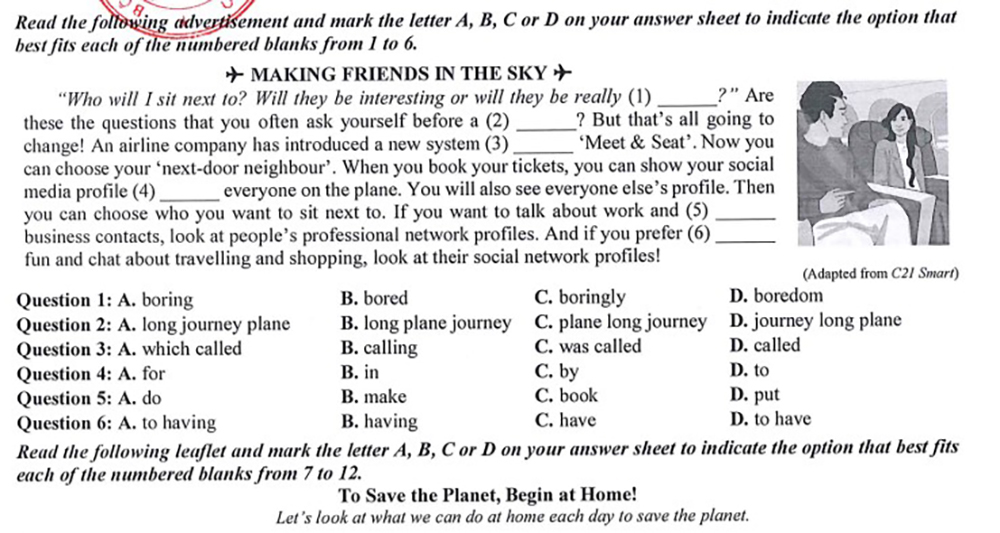2025 marks the first year that students under the new general education program will take the high school graduation exam. According to Ms. Dang Thuy Linh, head of the junior and senior high school English department at Viet Uc Hanoi School, this year's English exam has a revised structure, featuring 40 questions to be completed in 50 minutes.
The exam no longer includes pronunciation, stress, or short-answer questions. Grammar and sentence completion questions are now integrated into reading-fill, reading comprehension, and sentence ordering sections. Word form and collocations remain, but idiom questions have been removed. Reading comprehension has expanded from 12 to 18 questions, with new question types such as paraphrasing, identifying information within passages, and inserting sentences into appropriate places. Knowledge and comprehension level questions make up about two-thirds of the exam (26-27 questions), with the remaining questions at the application level to differentiate high-achieving students.
"Although there aren't many grammar questions, and they are mostly at the knowledge and comprehension level, they can be quite confusing", Linh said.
She suggested some key grammar topics for students to focus on:
1. Parts of speech and word order: These appear in questions 1, 2, and 6 of the reading-fill section in the sample exam.
- For this question type, students need to identify the words immediately before and after the blank, paying attention to the sentence structure to determine the required part of speech. If multiple words of the same part of speech are available, students must consider the meaning to choose the correct answer.
Example question 1:
Will they be interesting or will they be really (1)____?
| A. boring | B. bored | C. boringly | C. boredom |
Analyzing the sentence structure, we see that with "Be + really +...", the blank requires an adjective. In the answer choices, only A (boring) and B (bored) are adjectives. "-ing" adjectives have an active meaning, describing the characteristics of something that causes a feeling. Meanwhile, "-ed" adjectives have a passive meaning, used when the noun being modified is the recipient of the action. A is the correct answer.
"This is a knowledge-level question, but it can easily confuse students, leading to lost points", Linh said.
- With word order questions, students need to understand the context to determine the main noun and its modifiers.
Example question 2: Are these the questions that you often ask yourself before a____?
| A. long journey plane | B. long plane journey | C. plane long journey | D. journey long plane |
The answers above arrange the words plane, long, and journey in different orders. The main noun is "journey", modified by the noun "plane", creating the noun phrase "plane journey". This noun phrase is further modified by the adjective "long", which precedes the noun or noun phrase. The correct order is "long plane journey".
2. Gerunds and infinitives (V-ing, to V, V)
Example: And if you prefer ____ fun and chat about travelling and shopping, look at their social network profiles!
| A. to having | B. having | C. have | D. to have |
Students are often confused because "prefer" can be followed by "to V" or "V-ing". Their meanings are as follows:
- Prefer V-ing to V-ing: Prefer doing something to doing something else
- Prefer to V: Prefer to do something
Linh said this question is also only at the knowledge level, but students who are not confident in their knowledge might carelessly choose B or hesitate between B and D. The correct answer is D because the sentence does not compare two objects, and the following verb is "chat", not "chatting".
 |
Questions about parts of speech, word order, gerunds, and infinitives are found in questions 1, 2, and 6 of the sample exam. Screenshot. |
3. Quantifiers: These appear in questions 7 and 11, among others, in the sample exam.
Example in question 7: Farming with synthetic chemicals has killed insects and_____ animals.
| A. others | B. other | C. the others | D. another |
The blank precedes the noun "animals", so answers A and C are incorrect because they cannot be followed by a noun. "Animals" is a plural noun, so we choose "B - other" because "D - another" is used with singular nouns.
"For this question, students just need to analyze the part of speech immediately following the blank to choose the correct answer", Linh suggested.
Question 11: That helps reduce the of ____rubbishing you produce.
| A. number | B. level | C. amount | D. quality |
The blank is within the phrase "the.... of + rubbish (uncountable noun)". Students should eliminate answer A because "the number of" is used with countable plural nouns. Answer C is correct both grammatically and in meaning.
4. Prepositions and prepositional phrases: Questions 4 and 10, among others, in the sample exam.
- Prepositions: When working with this type of question, students should pay close attention to the words immediately before and after the blank to choose the appropriate preposition.
Example: When you book your tickets, you can show your social media profile_____everyone on the plane.
| A. for | B. in | C. by | D. to |
The phrase "show something to somebody" means "to show someone something". Therefore, the chosen preposition is "to", which is answer D.
- Prepositional phrases: These include phrases indicating reason or concession. To choose correctly, students need to understand the context of the sentence.
5. Conjunctions and conjunctive adverbs
- Sentence ordering questions: Students need to understand the function and meaning of conjunctions and conjunctive adverbs.
 |
Question 16 in the sample high school graduation English exam. Screenshot. |
For example, question 16 asks students to arrange sentences into a meaningful paragraph. Students can immediately see that "e. In conclusion,..." is the concluding sentence. To identify the topic sentence, students need to look at each sentence. Sentence c cannot be the opening sentence because it contains the phrase "this role", which requires a preceding sentence to explain the role. Sentence a is similar. Of the remaining sentences, sentence d is the topic sentence. Therefore, the order in answer A is correct.
6. Relative clauses and reduced relative clauses: Questions 3, 18, and 19 in the sample exam.
This is a section where students need to have a solid understanding of relative clauses and be able to analyze sentences accurately to determine what element is missing and whether the clause is active or passive.
Example: An airline company has introduced a new system (3) ____ "Meet & Seat".
| A. which called | B. calling | C. was called | D. called |
The answers are in the form of a relative clause (which called) and a reduced relative clause (calling, called). We analyze the sentence structure as follows:
An airline company (S1) has introduced (V1) a new system (O1) (3) _______ "Meet & Seat" (O2).
The blank requires a relative clause, consisting of a relative pronoun acting as S2 (modifying O1, "a new system") + V2. The meaning of the sentence is "An airline company has introduced a new system called 'Meet & Seat'". Thus, the relative clause needs to be in the passive voice. Among the options, only "called" (which is called) is in this form.
According to Linh, students might easily choose answer A because it seems to have a complete structure (including a relative pronoun and a verb). However, that is the trap if students do not carefully observe the sentence structure or have a solid understanding of relative clauses.
"This type of question is at the application level and clearly differentiates students", she said.
7. Phrasal verbs:
Example: Meanwhile, we _____ 80 million cans each day and 45,000 tonnes of plastic packaging each year.
| A. throw away | B. give in | C. pass out | D. another |
In this question, students need to grasp the meaning of the phrasal verbs in the answer choices and understand the context of the passage to choose the most appropriate option. With the issue of waste and pollution caused by humans, along with the meanings of the phrasal verbs "throw away", "give in", "pass out", and "put off", we find option A to be the most logical.
8. Participial clauses: Questions 20, 21, and 22 in the sample exam.
Students need to understand that a participial clause (which can begin with a present participle (V-ing), a past participle (P2), or a perfect participle (having P2)) is a subordinate clause sharing the same subject as the main clause. This clause is separated from the main clause by a comma.
Linh said that students often rely on translating the meaning to choose the answer instead of analyzing the sentence structure and identifying the subject of the subordinate/main clause.
Example: Equipped with machine learning algorithms, (22)______
A. Sophia can understand human speech and interact with people
B. human speech and interaction are becoming so easy to Sophia
C. the machine can help Sophia speak and interact with humans
D. interaction in speech between Sophia and humans takes place
In this question, the clause "equipped..." is in the passive voice, meaning "something is equipped with machine learning algorithms", so the main clause will refer to the object being equipped. Answer A is correct because the preceding sentence discusses how AI helps Sophia recognize faces and identify human emotions and gestures.
According to Linh, some question types that differentiate students are mainly in the reading-fill section and the two reading comprehension passages (from question 23 to 30). These are higher-level application questions. Students must have a good vocabulary related to topics covered in the curriculum, such as the environment, education, artificial intelligence and technology, mass media, and urbanization, to be able to answer them.
"Don't just look at common keywords and skim through the passage, using tricks to answer the questions. You have to understand the essence and have linguistic thinking to choose the correct answer and eliminate the wrong ones", Linh said.
 |
Linh (fourth from the right) with 12th-grade students. Photo: Provided by the interviewee. |
Binh Minh












